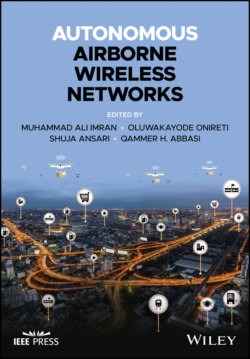Читать книгу Autonomous Airborne Wireless Networks - Группа авторов - Страница 13
2.1 Introduction
ОглавлениеThe use of unmanned aerial vehicles (UAVs) is desirable due to their high maneuverability, ease of operability, and affordable prices in various civilian applications, such as disaster relief, aerial photography, remote surveillance, and continuous telemetry. One of the promising application of UAVs is enabling the wireless communication network in cases of natural calamity and in hot spot areas during peak demand where the resources of the existing communication network have been depleted [1]. Qualcomm has already initiated field trials for the execution of fifth generation (5G) cellular applications [2]. Google and Facebook are also exploiting the use of UAVs to provide Internet access to far‐flung destinations [3].
The selection of an appropriate type of UAV is essential to meet the desired quality of service (QoS) depending on applications and goals in different environments. In fact, for any specific wireless networking application, the UAV altitude and its capabilities must be taken into account. UAVs can be categorized, based on their altitude, into low‐altitude platforms (LAPs) and high‐altitude platforms (HAPs). Furthermore, based on their structure, UAVs can be categorized as fixed‐wing and rotary‐wing UAVs. In comparison with rotary wings, fixed‐wing UAVs move in the forward direction to remain aloft, whereas rotary‐wing UAVs are desired for applications that require UAVs to be quasi‐stationary over a given area. However, in both types, flight duration depends on their energy sources, weight, speed, and trajectory.
The salient features of UAV‐based communication network are the air‐to‐ground (AG) and air‐to‐air (AA) propagation channels. Accurate channel modeling is imperative to fulfill the ever‐increasing requirements of end users to transfer data at higher rates. The available channel models for AG propagation are designed either for terrestrial communication or for aeronautical communications at higher altitudes. These models are not preferable for low‐altitude UAV communication, which uses small size UAVs in different urban environments. On one hand, the AG channel exhibits higher probability of line‐of‐sight (LoS) propagation, which reduces the transmit power requirement and provides higher link reliability. In cases with non‐line‐of‐sight (NLoS), shadowing and diffraction losses can be compensated with a large elevation angle between the UAV and the ground device. On the other hand, UAV mobility can incur significant temporal variations in both the AG and AA propagation due to the Doppler shift.
Small UAVs may experience airframe shadowing due to their flight path with sharper changes in pitch, yaw, and roll angle. In addition, distinct structural design and material of UAV body may contribute additional shadowing attenuation. This phenomenon has not yet been extensively studied in the literature.
Despite the number of promising UAV applications, one must address several technical challenges before the widespread applicability of UAVs. For example, while using UAV in aerial base station (BS) scenario, the important design considerations include radio resource management, flight time, optimal three‐dimensional deployment of UAV, trajectory optimization, and performance analysis. Meanwhile, considering UAV in the aerial user equipment (UE) scenario, the main challenges include interference management, handover management, latency control, and three‐dimensional localization. However, in both scenarios, channel modeling is an important design step in the implementation of UAV‐based communication network. This chapter provides an overview of the use of UAV as aerial UEs and aerial BSs and discusses the technical challenges related to AG channel modeling, airframe shadowing, optimal deployment of UAVs, trajectory optimization, resource management, and energy efficiency.
